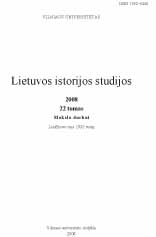Lietuvos vaizd(avim)as šiuolaikiniuose Rusijos istorijos vadovėliuose
Lithuania ’s Image in Modern history schoolbooks of Russia
Author(s): Nerijus ŠepetysSubject(s): History
Published by: Vilniaus Universiteto Leidykla
Summary/Abstract: This article analyses Russian schoolbooks of history, which have been received from bilateral Lithuanian-Russian Commission of Historians in 2007. The group comprises more then ten books selected by the Russian historians, all of which (except the textbook of Russian history) are used in Russian schools (mainly in secondary schools) up until these days. Not included are all subsequently published textbooks of modern Russian history, written for the 10th grade pupils, with a “blessing” of the president of Russian Federation. The analysis highlights “Lithuanian” aspect, that is: how separate subjects of Lithuanian history are being delineated; in what contexts and meanings Lithuania and Lithuanians figure; what particular misapprehensions, mutilations and mistakes are seen. The meaningful passages of the Lithuanian history are discussed in factual, contextual and evaluative aspects. In the textbooks for 6 to 11 grades, the most attention is being paid to the early period of the Grand Duchy of Lithuania (GDL) (till the end of the 14th C.), with special note to the process of the “unification of Russian lands”. According to the typology suggested by the Russian historian Alexander Filiyushkin, the GDL is considered to be a “true Rus” and also a “victim of Lithuanians’ occupation”. Generally, medieval Lithuanian state is being perceived either as a “historical misunderstanding”, or as an “essentially Russian lands”, while Lithuania in the Union with Poland, and particularly in the composition of the Russian empire receives only episodical mention in separate schoolbooks. In Russian schoolbooks of the modern history two passages are granted with exceptional attention: the events, related to the circumstances and results of the so-called Molotov-Ribbentrop Pact and the collapse of the Soviet Union. Overall, these schoolbooks comprehends a wide variety of material concerning the “Lithuanian question”: objective and unfair exposition of major factual data, conscious and unconscious veilings, multiperspective and one-sided interpretations, neutral and subtle misrepresentations. However, all these problems related with the Lithuanian history are equally characteristic to the representation of Russian history itself. Frequently Russia is being perceived as a historically static and invariable “value”. Most of the schoolbooks lack conceptuality, and this shortage is being (consciously or unconsciously) counterbalanced with mythical and ideological “leading ideas”, such as political messianism, deterministic apologetics and nationalism of a superstate. These assumptions, conditioned by peculiar outlook and sometimes reinforced with up-to-date principals of politics of history, determine all veiling and sophistications when the matter concerns Lithuanian history.
Journal: Lietuvos istorijos studijos
- Issue Year: 2008
- Issue No: 22
- Page Range: 144-162
- Page Count: 19
- Language: Lithuanian

